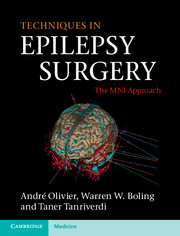Book contents
- Frontmatter
- Contents
- Acknowledgment
- Preface
- 1 History of epilepsy surgery
- 2 The search for the epileptic focus: investigation of the surgical candidate
- 3 Surgical anatomy
- 4 Neuronavigation and preoperative brain mapping
- 5 Stereoelectroencephalography (stereotactic intracranial recording)
- 6 Anesthesia and awake procedure
- 7 Peroperative brain mapping
- 8 Endopial resection (intervascular endopial gyral emptying)
- 9 Surgery of temporal lobe epilepsy: cortico-amygdalohippocampectomy
- 10 Surgery of temporal lobe epilepsy: transcortical selective amygdalohippocampectomy
- 11 Surgery of central area epilepsy
- 12 Surgery of frontal lobe epilepsy
- 13 Surgery of parietal lobe epilepsy
- 14 Surgery of insular lobe epilepsy
- 15 Surgery of occipital lobe epilepsy
- 16 Hemispherectomy
- 17 Callosotomy
- 18 Epilepsy and brain tumors
- 19 Surgical treatment of cortical dysplasias
- 20 Reoperations in failed epilepsy surgery
- 21 Alternative procedures in surgery for epilepsy
- 22 Complications of epilepsy surgery
- 23 Quality of life after epilepsy surgery
- Index
- References
2 - The search for the epileptic focus: investigation of the surgical candidate
Published online by Cambridge University Press: 05 October 2012
- Frontmatter
- Contents
- Acknowledgment
- Preface
- 1 History of epilepsy surgery
- 2 The search for the epileptic focus: investigation of the surgical candidate
- 3 Surgical anatomy
- 4 Neuronavigation and preoperative brain mapping
- 5 Stereoelectroencephalography (stereotactic intracranial recording)
- 6 Anesthesia and awake procedure
- 7 Peroperative brain mapping
- 8 Endopial resection (intervascular endopial gyral emptying)
- 9 Surgery of temporal lobe epilepsy: cortico-amygdalohippocampectomy
- 10 Surgery of temporal lobe epilepsy: transcortical selective amygdalohippocampectomy
- 11 Surgery of central area epilepsy
- 12 Surgery of frontal lobe epilepsy
- 13 Surgery of parietal lobe epilepsy
- 14 Surgery of insular lobe epilepsy
- 15 Surgery of occipital lobe epilepsy
- 16 Hemispherectomy
- 17 Callosotomy
- 18 Epilepsy and brain tumors
- 19 Surgical treatment of cortical dysplasias
- 20 Reoperations in failed epilepsy surgery
- 21 Alternative procedures in surgery for epilepsy
- 22 Complications of epilepsy surgery
- 23 Quality of life after epilepsy surgery
- Index
- References
Summary
Introduction
The investigation of the surgical patient is essentially the search for the epileptic focus.
The neurosurgeon must understand that the clinical manifestations of a seizure result from activation of a brain region, the so-called symptomatic zone, which may be distant from the actual epileptic focus, the so-called ictal zone. EEG, as well, must be interpreted carefully for its localization value since the abnormal activity first detected by the electrode may in fact have originated from a distant brain site that may not be sampled adequately with an EEG recording electrode. Much effort is put into the search for an imaging abnormality since a lesion seen on MRI has considerable value in the localization of the seizure focus. In surgery for epilepsy, it is the true epileptic focus or ictal zone that is essential to recognize and target with treatment to realize the best results in seizure control.
Rasmussen has developed a useful concept of localization to orient the investigation, determine the modalities of resection, and explain success or failure of resective surgery. It is based on three levels of localization that constitute the surgical hypothesis or the deinition of the epileptogenic zones and the area of resection that is likely to abolish the seizures.
- Type
- Chapter
- Information
- Techniques in Epilepsy SurgeryThe MNI Approach, pp. 15 - 29Publisher: Cambridge University PressPrint publication year: 2012



